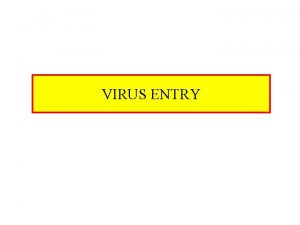Molecular analysis of Vaccinia Virus Entry n n


- Slides: 2


Molecular analysis of Vaccinia Virus Entry n n n n n n n n n n Vaccinia virus (VV) is an enveloped DNA virus with wide host range andenters cells via plasma membrane fusion. Previous studies have identified amonoclonal antibody(m. Ab) B 2 that recognized cell surface molecules and neutralized 95% VV infection by blocking virus binding. In addition, lambda expression cloning with this m. Ab resulted in isolation of a 4. 2 kb c. DNA clone. A 1. This A 1 c. DNA contains an open reading frame (ORF) of 1, 300 amino acidsand shares no homology with any known sequences in database. The major objectives of this study are to analyze the gene product of A 1 c. DNA and to determine if it facilitated VV entry. A 1 c. DNA was fused with bacteria glutathione-S-transferase (GST) to produce A 1 -GST fusion protein, which intern was used as an antigen to generate more monoclonal antibodies that could block VV infection. Four m. Abs 1 -5 E-5 H m. Ab, 5 -4 H-3 B m. Ab, 4 -6 G-5 B m. Ab, and 4 -1 D-5 G m. Ab were isolated. 1 -5 E-5 H and 5 -4 H-3 B could approximately contribute to 95% of efficiency for blocking the virus infection, while 4 -6 G-5 B and 4 -1 D-5 G m. Ab could only reach 29% and 50% respecitvely. In order to map out the epitopes within A 1 protein for these m. Abs, aseries of A 1 -GST 3' -deletion clones were generated. The result indicated thatthese m. Abs recognize four different epitopes localized at the N-terminal regionof A 1. In addition, these m. Abs also stain cell surface indicating that the recognition sites were situated outside of cells. Therefore, this A 1 protein couldbe a type I transmenbrane protein. To understand whether the A 1 gene product serves as the cellular receptor of VV, a plasmid expressing the full-length A 1 c. DNA in mammalian cells was prepared and used to determine the role of A 1 c. DNA clone in virus entry. Futur study will determine ifoveroxperssion of the A 1 gene product will result in increase of virus binding. This study also intend to investigate the role of viral envelope proteins in virus attachment during virus entry. Each envelope proteins were overexpressed in E. coli and their ability to interfere with m. Ab B 2 interactionwith cells was measured. On the other hand, mutant viruses defective of A 34 R, A 36 R, B 5 R, or F 13 L of envelope proteins were also used to determine the effect of envelope proteins in virus entry. Results from these expermentsrevealed that lack of above envelope protein does not affect the mechanism ofvirus entry.



